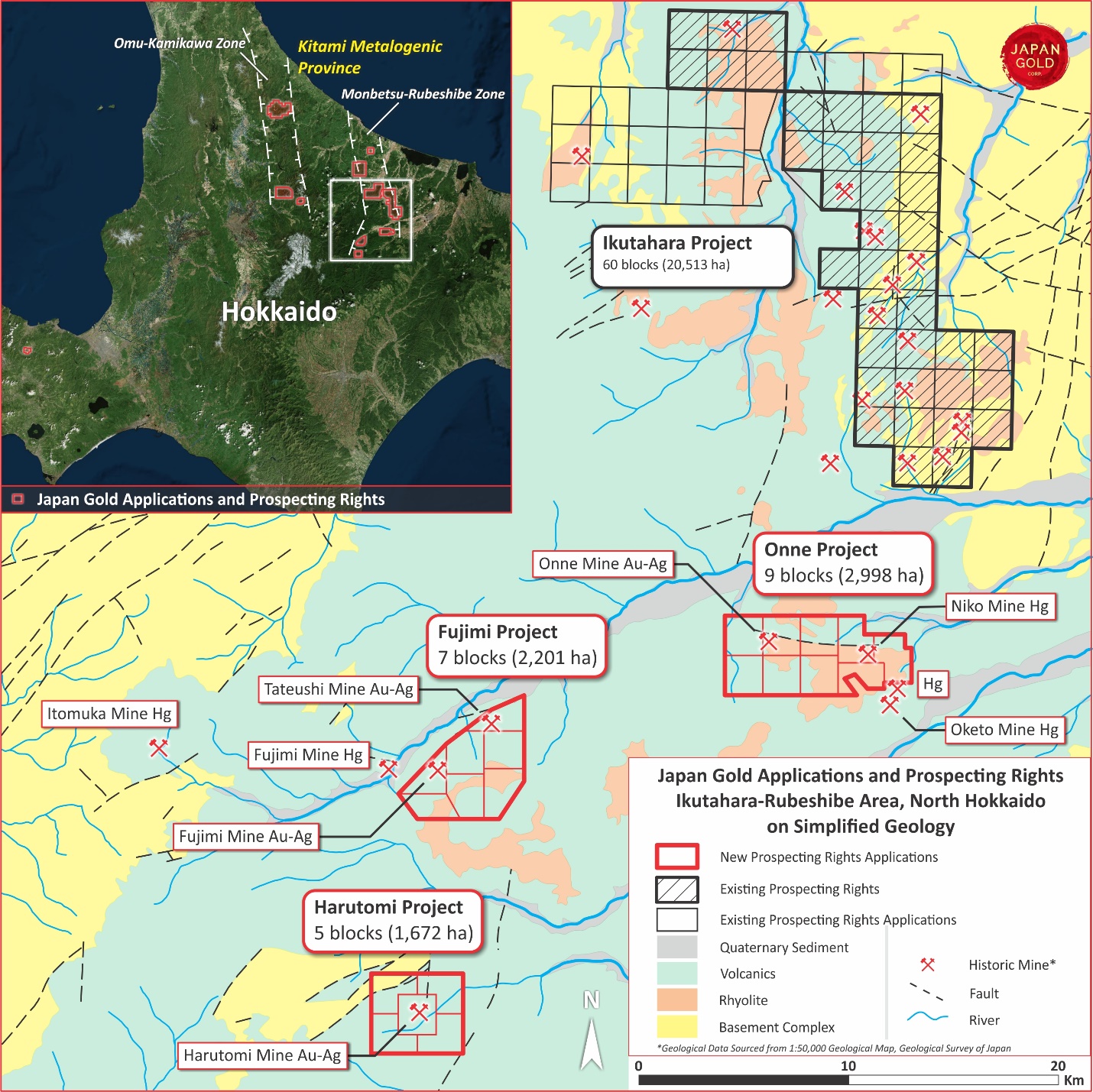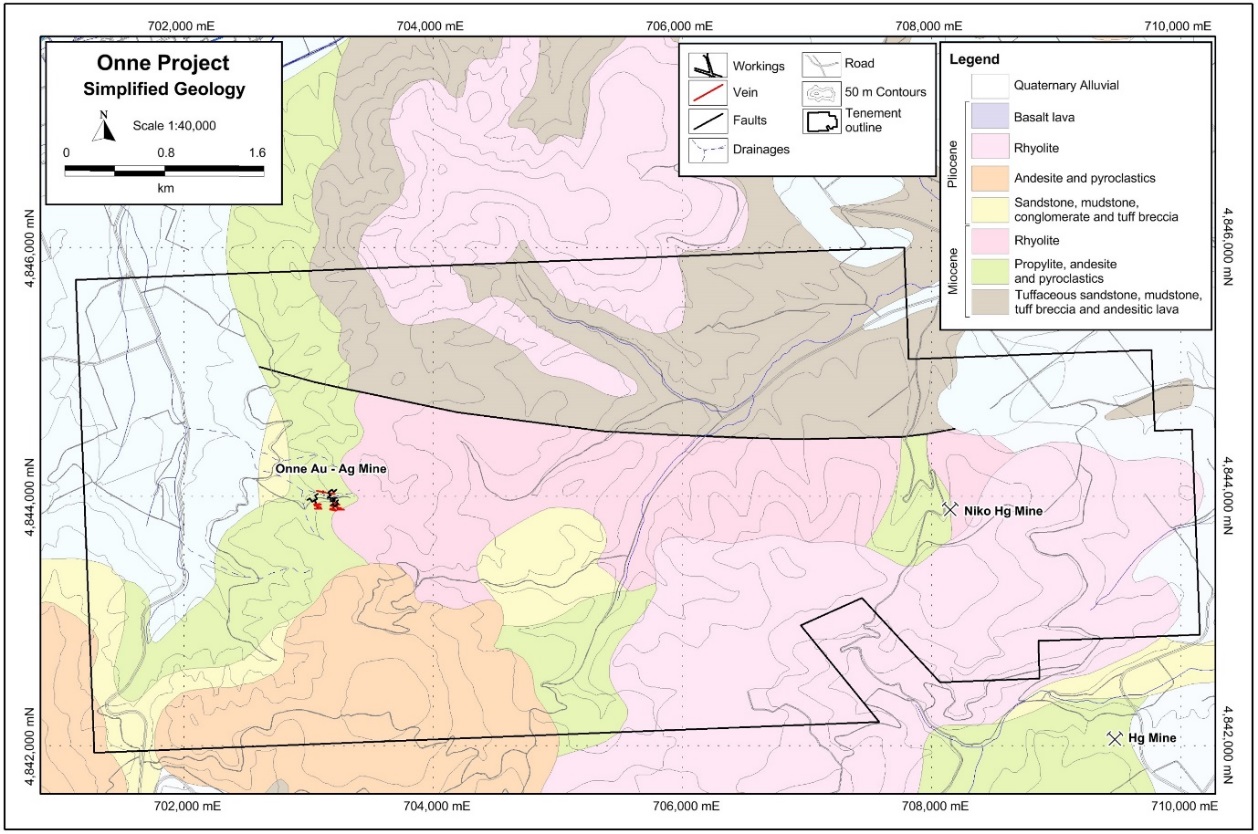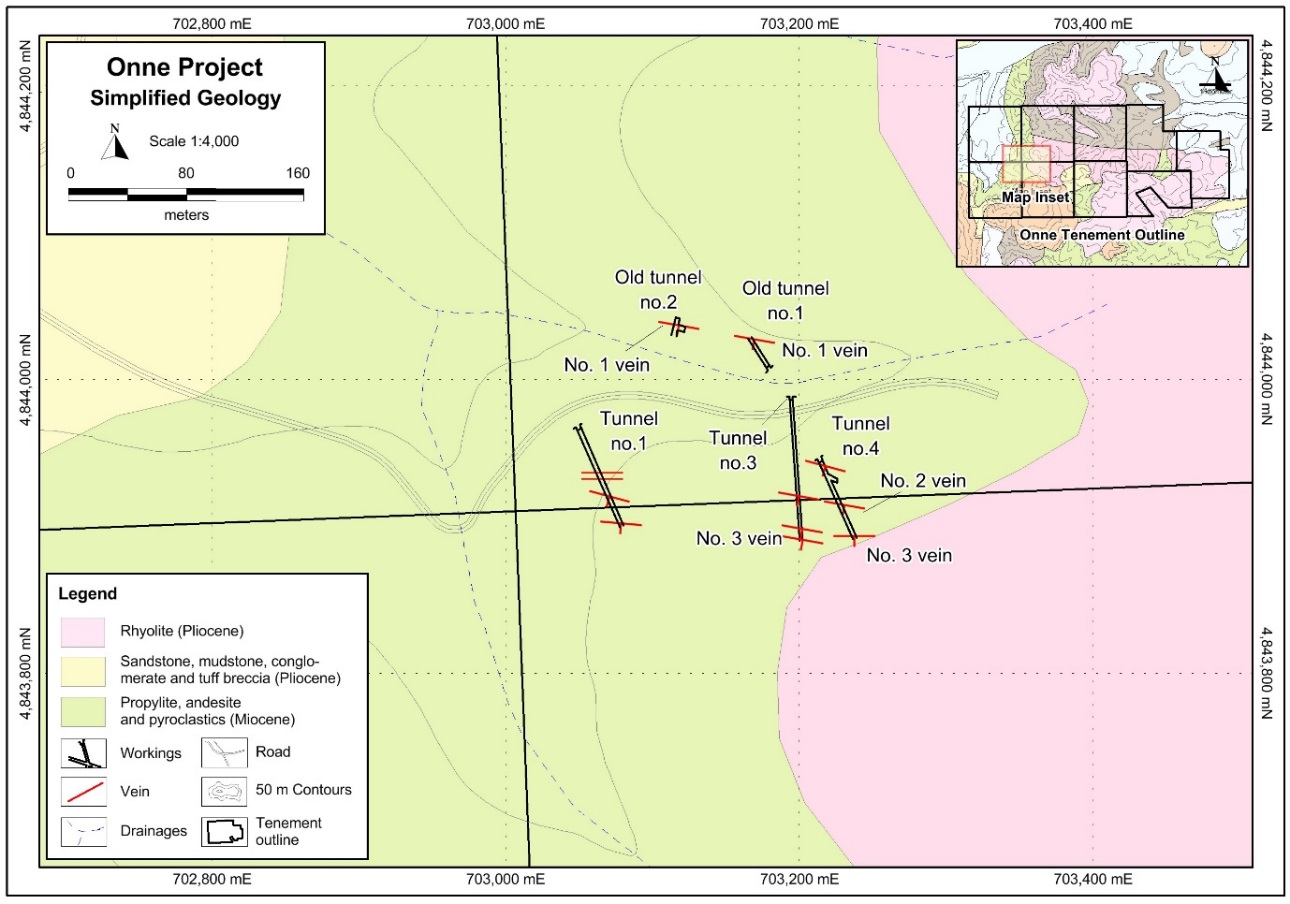The Fujimi & Onne Projects
Overview
| Commodity: | Gold |
| Target: | Low Sulphidation Epithermal Gold |
| Location: | Northern Hokkaido, Japan |
| Size: | 2,201 Ha (Fujimi) 2,998 Ha (Onne) |
| Permitting Status: | All prospecting rights applications have been accepted and the land is reserved for Japan Gold |
Highlights
- The Onne Project covers the historic Onne gold-silver and Niko mercury mines. At Onne the epithermal quartz veins are developed along east-northeast to east-west orientated structures. Minor production in the years of 1936 and 1928 reported average gold grades of 5 g/t gold and 15 g/t gold respectively.
- The Fujimi Project covers the historic Fujimi and No.2 Tateushi gold-silver mines and surrounds.
- At Fujimi, five quartz veins hosted in rhyolite were mined in the 1930’s minor production records noted an average grade of 15 g/t gold and 20 g/t silver1.
- The No.2 Tateushi mine had exploration development carried out in the late 1930’s, however this work was probably curtailed by the government moratorium and closure of gold mines in Japan in 1943.
- Proven high-grade mineralization in the form of quartz-chalcedony-adularia-sericite±calcite quartz vein swarms, with underground sampling results including 2 m @ 31.7 g/t Au & 70 g/t Ag, and 3 m @ 11.3 g/t Au & 36 g/t Ag at Fujimi1.
- A genetic relationship exists between epithermal gold mineralization and high-level mercury present in several mercury mines located within and immediately around the project area, suggesting post-mineral erosion of the system is limited.
- No modern systematic exploration or exploration drilling to test for lateral and vertical extensions to the known, historically mined veins has been completed.
- Japan Gold proposes to explore the potential link between mercury and epithermal gold mineralization in both license application areas.
- Exploration to date is limited to the area of known veins and no exploration drilling has been completed to test the deeper extensions to the veins historically mined to a shallow level.
- Japan Gold will seek to define the limits of the hydrothermal alteration cells around the historic mines and use surface mapping and geochemistry to target new zones and extensions to previously exploited vein systems for testing by scout drilling.
Project Details
The Fujimi Project comprises seven contiguous Prospecting Rights Application blocks (2,201 Ha) and the Onne Project comprises nine contiguous Prospecting Rights Application blocks (2,998 Ha). The blocks contain historical gold-silver and mercury occurrences, and are located about 10 km apart in the Okhotsk district of northeastern Hokkaido.
History
The project lies within the Kitami mining region along the southern portion of the N-S trending Monbetsu-Rubeshibe graben zone, which hosts numerous epithermal mineral occurrences, historical mines and workings dating from the early 1900’s.
The Fujimi mine produced small amounts of gold and silver from 50 tonnes of ore mined at 15 g/t Au and 20 g/t Au from underground lodes during 1935-39 and 30 tonnes of ore mined at 1-2 g/t Au from open-pits in 19801. As part of a regional metallogenic study, the MMAJ and Geological Survey of Japan (GSJ) undertook regional gravity surveys in the area.
Exploration and small-scale underground development was conducted by local people from 1949 within the Fujimi mine area in the western part of the project. Historical maps of geology and this development contain limited information but indicate the veins host significant intervals of mineralization, including 2 m @ 31.7 g/t Au & 70 g/t Ag, and 3 m @ 11.3 g/t Au & 36 g/t Ag1. A total of 724 m of drift development and 718 m of cross-cuts were completed in an underground adit at 780 m RL, advanced by local miners on a vein zone at the No. 2 Tateushi mine in the northeastern part of the project. In this zone, more than six sub-parallel quartz veins were located with vein thicknesses ranging from 0.15 to 0.70 m wide. Twenty samples collected from these veins returned trace gold values, except for one sample, that yield 12 g/t gold and 10.6 g/t Ag across a 0.3 m vein width1. The Fujimi mercury mine lies about one kilometre to the west of the tenement.
The Onne Project contains the historic Onne gold-silver mine and the Niko mercury mine. Production from Onne is not well documented but includes 75 tonnes of ore at 5 g/t Au and 40 g/t Ag in 1936 and 40 tonnes of ore at 15 g/t Au in 19381. At Niko, disseminated cinnabar was mined from an acid altered rhyolite intrusion. Diamond drilling by the MMAJ in 1989-91 beneath the Oketo mercury mine, located two kilometres south of the Onne Project, intersected narrow, weakly mineralized quartz veins containing fine-grained quartz fill including chalcedony and adularia.
Geology and Mineralisation
The gold mineralization styles at the Fujimi and Onne Projects are classified as rift-related, low-sulfidation epithermal. Mineralization is typically associated with quartz-chalcedony-adularia-sericite±calcite in silicified and veined- or brecciated-structures, including dark sulfidic material, termed ginguro bands. The veins are characterized by massive to banded quartz-chalcedony and vein breccia. Lattice-blade, ‘bosa’ textures are also described. The veins are associated with zones of silicification and a spatial relationship between gold-silver veins, mercury occurrences and possible intrusions (e.g., rhyolite stocks and domes) is suspected, based on MMAJ report descriptions.
Mineralization within the Fujimi Project is hosted in multiple sub-parallel quartz veins that trend N25° - 80° E and dip moderately to steeply towards the northwest. These veins occur in two locations, each about 150 m by 100 m, known as the Fujimi mine and No. 2 Tateushi mine. MMAJ, 19901 compiled historical geochemical maps of old workings in the Fujimi mine indicate vein thicknesses that range from 0.2 to 4.0 m, with gold values up to 32 g/t Au and 70 g/t Ag. An 11 m long zone in one of the workings returned an average of 6.3 g/t Au and 25 g/t Ag across an average vein width of 2.9 m at approximately 1,090 m RL (note raw analytical data upon which published gold-silver values and associated maps are based are not published).
The quartz veins in both mine areas are hosted in Lower to Middle Miocene tuff, propylite and rhyolite volcanic rocks. Pliocene andesite and basalt unconformably overlie these Miocene lithologies. The Mesozoic Hidaka Formation, consisting of sandstone, slate and hornfels, form the basement.
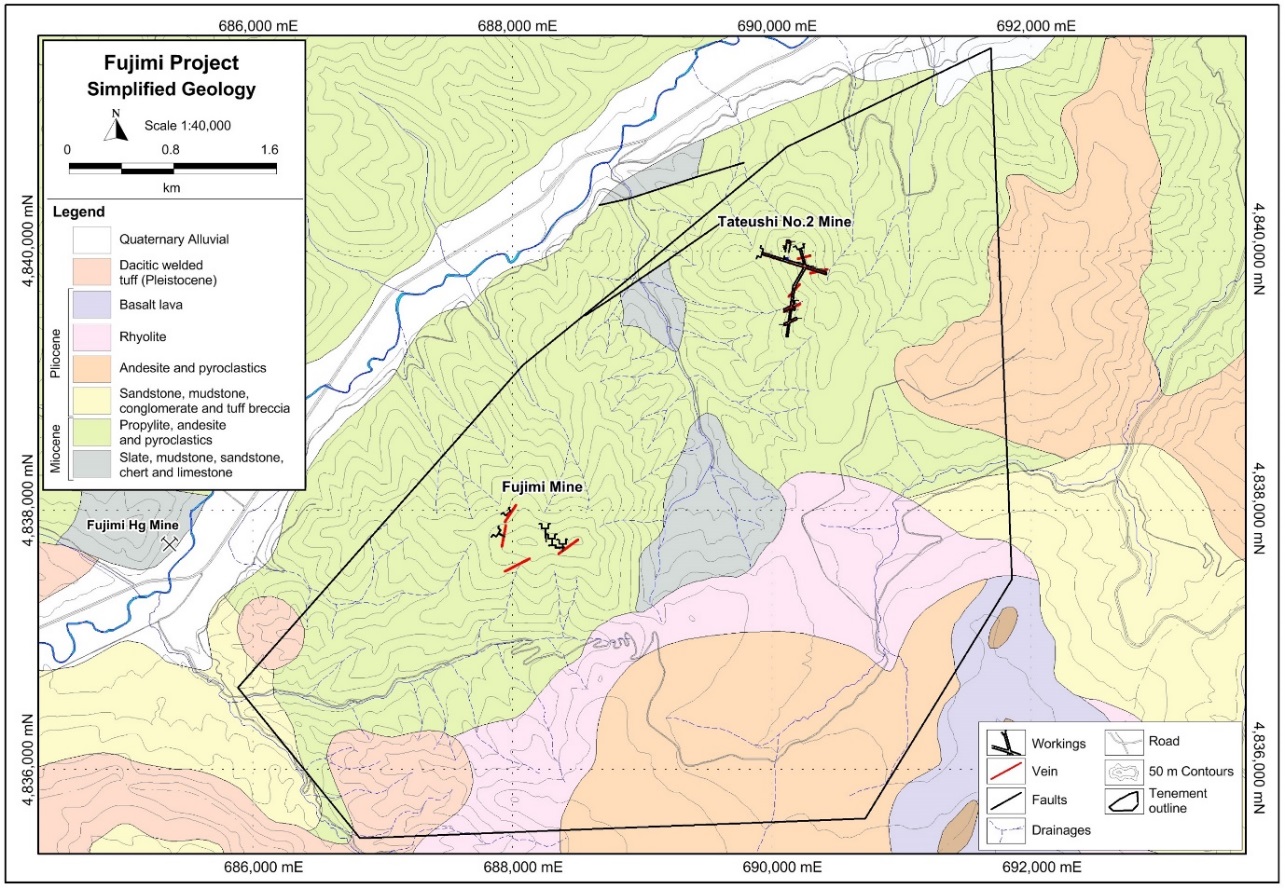 Simplified geology, historical workings and veins in the Fujimi application license area.
Simplified geology, historical workings and veins in the Fujimi application license area.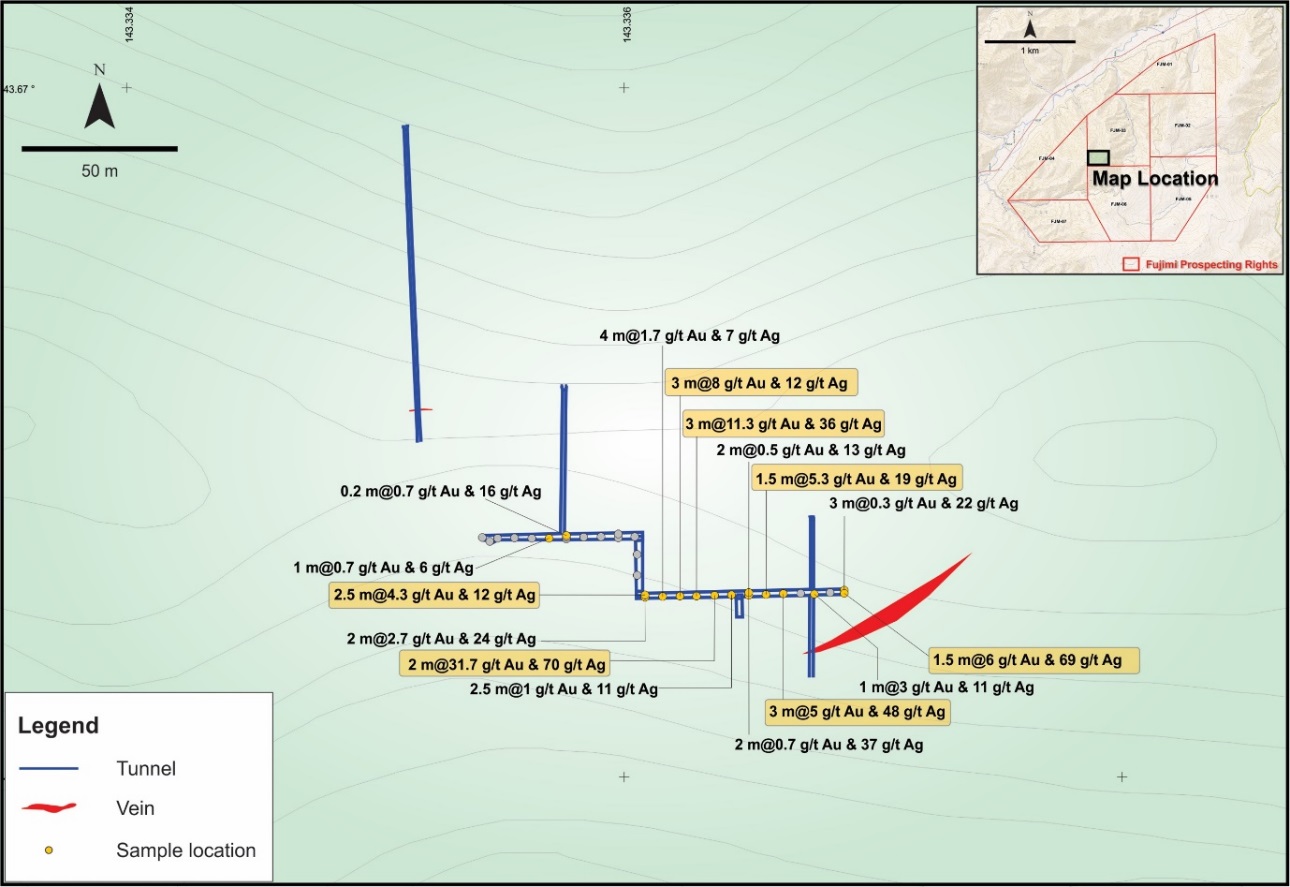 Significant assay results1 from underground development in the Fujimi mine (plan view).
Significant assay results1 from underground development in the Fujimi mine (plan view).
Mineralization in the Onne Project area is hosted in Lower Miocene rhyolitic rocks consisting of tuff, tuffaceous siltstone, flow-banded rhyolite and plagioclase-hornblende-phyric rhyolite flows. The rhyolites are covered by andesitic rocks locally. Six quartz veins, trending N60° W to E-W and dipping 55° to 80° S, are reported over an east-elongate area that is 200 m by 150 m. The known veins range up to 0.8 m wide (widths range from 0.07 - 0.8m) with historical mine grades of 5-15 g/t Au and 40 g/t Ag. The Onne veins consist of white, transparent, massive, banded, and locally lattice-bladed ‘bosa’ quartz and are associated with zones of silicification.
Exploration
The Company has completed a compilation of published exploration data and historical mining data for the Fujimi and Onne Projects. No field work has yet been undertaken on the project by Japan Gold.
Exploration Potential
Previous studies in the Fujimi and Onne areas indicate that gold and mercury mineralization are genetically-related. In many epithermal systems, mercury typically occurs at the highest paleo-levels, above banded and bladed epithermal quartz veins, and acts as a pathfinder element in precious metal exploration. The multiple, sub-parallel sets of epithermal quartz-chalcedony veins in the Fujimi and Onne Projects are associated with adjacent mercury mineralization (e.g., Fujimi, Niko and Oketo mercury mines). This relationship suggests that post-mineral erosion of the system is limited and that the highest levels of the epithermal field(s) are likely preserved. The limited, historic underground development of the veins in the licenses have yet to adequately test the potential for bonanza-grade gold-silver veins at depth.
The results of the MMAJ drilling beneath the Oketo mercury mine, located south of the Onne Project, indicate that weakly mineralized, quartz-chalcedony-adularia veins occur at depth. The underground workings within the Fujimi and Onne mine areas have exploited similar, weakly mineralized veins but higher gold-silver mineralization is present locally, as indicated by the high-grade intervals reported from the Fujimi mine.
A genetic relationship between mercury and epithermal gold mineralization exists in the Sulphur Creek-Knoxville mercury mining districts of California, which were mined in the late 19th century. In the latter part of the 1970’s, Homestake Mining Company recognized this relationship, and subsequently discovered the McLaughlin epithermal gold deposit by drilling beneath a cinnabar- bearing sinter2. The McLaughlin deposit produced about 3.5 million ounces of gold3.
Japan Gold proposes to explore the potential link between mercury and epithermal gold mineralization in both license application areas. Exploration to date is limited to the area of known veins and no exploration drilling has been completed to test the deeper extensions to the veins historically mined to a shallow level. Japan Gold will seek to define the limits of the hydrothermal alteration cells around the historic mines and use surface mapping and geochemistry to target new zones and extensions to previously exploited vein systems for testing by scout drilling.
References
1 Metals Mining Agency Japan (MMAJ), 1990. Nippon Mining Corp (NMC) Survey Report 3, p. 241-253.
2 Peters, 1991. Gold-Bearing Hot Spring Systems of the Northern Coast Ranges, California. Economic Geology, v86, 1991, pp 1519-1528.
3 Sherlock, 1995. Origin of the McLaughlin Mine Sheeted Vein Complex: Metal Zoning, Fluid Inclusion, and Isotope Evidence. Economic Geology, v90, 1995, pp 2156-2191.


